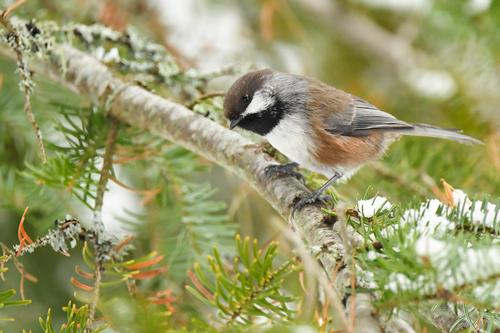Plants and Animals
Poecile hudsonicus Boreal chickadee
Key Characteristics
The boreal chickadee is a small songbird, 4.9-5.5 in (12.5-14 cm) in length. It has a grayish-brown cap and back, with a black bib. Sides and flanks are brown to rufus. It has a small white cheek patch. The boreal chickadee appears more brown than the black-capped chickadee (Poecile atricapillus), the only other chickadee species found in Michigan, which is easily distinguished by its black cap and larger white cheek patch.
Status and Rank
US Status: No Status/Not Listed
State Status: SC - Special Concern (rare or uncertain; not legally protected)
Global Rank: G5 - Secure
State Rank: S2 - Imperiled
Occurrences
| County | Number of Occurrences | Year Last Observed |
|---|
Information is summarized from MNFI's database of rare species and community occurrences. Data may not reflect true distribution since much of the state has not been thoroughly surveyed.
Habitat
Boreal chickadees inhabit boreal forests and other conifer dominated forest types, particularly those that are wet and contain high proportions of spruce trees (Picea sp.)
Specific Habitat Needs
Snag/cavity needed in: Boreal forest; Hardwood-conifer swamp; Muskeg; Northern shrub thicket.
Natural Community Types
For each species, lists of natural communities were derived from review of the nearly 6,500 element occurrences in the MNFI database, in addition to herbarium label data for some taxa. In most cases, at least one specimen record exists for each listed natural community. For certain taxa, especially poorly collected or extirpated species of prairie and savanna habitats, natural community lists were derived from inferences from collection sites and habitat preferences in immediately adjacent states (particularly Indiana and Illinois). Natural communities are not listed for those species documented only from altered or ruderal habitats in Michigan, especially for taxa that occur in a variety of habitats outside of the state.
Natural communities are not listed in order of frequency of occurrence, but are rather derived from the full set of natural communities, organized by Ecological Group. In many cases, the general habitat descriptions should provide greater clarity and direction to the surveyor. In future versions of the Rare Species Explorer, we hope to incorporate natural community fidelity ranks for each taxon.
Management Recommendations
Protect and maintain landscapes containing large areas of medium sized and mature lowland coniferous forest. This species tends to avoid young and regenerating stands and prefers mature stands in the winter, so maintaining adequate old coniferous forest at the landscape-level is likely to benefit this species. Maintain stands with abundant snags and retain large diameter spruce, balsam fir, and aspen as preferred tree species. Retain trees with existing nest cavities, snags, and dead stumps in harvested areas.
Management Avoidance Period: From first week of May to fourth week of July.
Active Period
Nesting from first week of May to fourth week of July
Survey Methods
Surveys for this species are typically point counts or transects through suitable habitat during the breeding season.
Point count, transect
Survey Period: From first week of May to fourth week of June
Time of Day: Morning (after sunrise)
References
Survey References
- Bibby, C.J., N.D. Burgess, and D.A. Hill. 1992. Bird Census Techniques. Academic Press, New York.
Technical References
- Ng, A. M. B., and A. P. Kortenhoven. 2025. Species Abstract for Poecile hudsonicus (boreal chickadee). Michigan Natural Features Inventory, Lansing, Michigan, USA.


